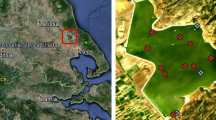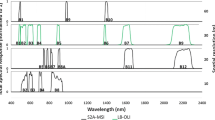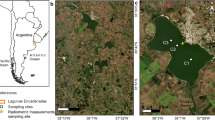Abstract
Under the current Anthropocene Epoch there is an urgent need to deliver high‐quality data, information and knowledge to the decision-making process for a sustainable management of environmental concerns, in particular for inland water. Most literature address the advantages brought by remote sensing (RS) techniques in operational monitoring and management of lakes. In the present work, optical RS is applied to a complex ecosystem, the turbid eutrophic shallow Lake Trasimeno (Italy). A first example of RS application addresses the use of high frequency spectroradiometric measurements collected by a WISPstation to retrieve intra-inter daily and seasonal dynamics of chlorophyll-a and phycocyanin. A second section focuses on long term trends of water quality by means of satellite data time series for the whole lake surface. Then we exploit the latest generation of hyperspectral satellite images (PRISMA and DESIS) utilizing the high spectral resolution and improving the accuracy of estimated lake water quality. Finally, high spatial resolution satellite data is used for a finer scale map** of bottom substrates. Application of these techniques improved scientific understanding on the timing, composition and distribution of phytoplankton blooms, the role of nutrients and climate drivers as well as changes in the extent and composition of aquatic plants.
Access this chapter
Tax calculation will be finalised at checkout
Purchases are for personal use only
Similar content being viewed by others

References
Organisation for Economic Co-operation and Development (2001) OECD environmental strategy for the first decade of the 21st Century: adopted by OECD environmental ministers. OECD
Giovannini E (2008) Understanding economic statistics: an OECD perspective. OECD, Paris
Coicaud JM, Zhang J (2011) The OECD as a global data collection and policy analysis organization: some strengths and weaknesses. Global Pol 2(3):312–317
Directive (2000) Directive 2000/60/EC of the European Parliament and of the council of 23 October 2000 establishing a framework for community action in the field of water policy. Off J Europ Commun L327:1–72
Garrote L (2017) Managing water resources to adapt to climate change: facing uncertainty and scarcity in a changing context. Water Resour Manage 31(10):2951–2963
Carvalho L, Mackay EB, Cardoso AC, Baattrup-Pedersen A, Birk S, Blackstock KL, Borics G, Borja A, Feld CK, Ferreira MT, Globevnik L (2019) Protecting and restoring Europe’s waters: an analysis of the future development needs of the water framework directive. Sci Total Environ 658:1228–1238
Woolway RI, Kraemer BM, Lenters JD, Merchant CJ, O’Reilly CM, Sharma S (2020) Global lake responses to climate change. Nat Rev Earth Environ 1(8):388–403
Williamson CE, Saros JE, Vincent WF, Smol JP (2009) Lakes and reservoirs as sentinels, integrators, and regulators of climate change. Limnol Oceanogr 54:2273–2282
Adrian R, O’Reilly CM, Zagarese H, Baines SB, Hessen DO, Keller W, Livingstone DM, Sommaruga R, Straile D, Van Donk E, Weyhenmeyer GA (2009) Lakes as sentinels of climate change. Limnol Oceanogr 54(6):2283–2297
Bukata RP, Jerome JH, Kondratyev KY, Pozdnyakov DV (1991) Satellite monitoring of optically-active components of inland waters: an essential input to regional climate change impact studies. J Great Lakes Res 17(4):470–478
Yang J, Gong P, Fu R, Zhang M, Chen J, Liang S, Xu B, Shi J, Dickinson R (2013) The role of satellite remote sensing in climate change studies. Nat Clim Chang 3(10):875–883
Hu C, Lee Z, Ma R, Yu K, Li D, Shang S (2010) Moderate resolution imaging spectroradiometer (MODIS) observations of cyanobacteria blooms in Taihu Lake, China. J Geophys Res: Oceans 115(C4)
Tyler AN, Hunter PD, Spyrakos E, Groom S, Constantinescu AM, Kitchen J (2016) Developments in Earth observation for the assessment and monitoring of inland, transitional, coastal and shelf-sea waters. Sci Total Environ 572:1307–1321
Odermatt D, Gitelson A, Brando VE, Schaepman M (2012) Review of constituent retrieval in optically deep and complex waters from satellite imagery. Remote Sens Environ 118:116–126
Ogashawara I, Mishra DR, Mishra S, Curtarelli MP, Stech JL (2013) A performance review of reflectance based algorithms for predicting phycocyanin concentrations in inland waters. Remote Sens 5(10):4774–4798
Gholizadeh MH, Melesse AM, Reddi LA (2016) Comprehensive review on water quality parameters estimation using remote sensing techniques. Sensors 16:1298
Greb S, Dekker AG, Binding C, Bernard S, Brockmann C, DiGiacomo P, Griffith D, Groom S, Hestir E, Hunter P, Kutser T (2018) Earth observations in support of global water quality monitoring. International Ocean-Colour Coordinating Group
Kutser T, Hedley J, Giardino C, Roelfsema C, Brando VE (2020) Remote sensing of shallow waters–a 50 year retrospective and future directions. Remote Sens Environ 240:111619
Bresciani M, Pinardi M, Free G, Luciani G, Ghebrehiwot S, Laanen M, Giardino C et al (2020) The use of multisource optical sensors to study phytoplankton spatio-temporal variation in a Shallow Turbid Lake. Water 12(1):284
Taticchi MI (1992) Studies on Lake Trasimeno and other water bodies in Umbria Region (Central Italy). In: Guilizzoni P, Tartari G, Giussani G (eds) Limnology in Italy. Tipografia Griggi, Baveno, Italy, pp 295–317
Carosi A, Ghetti L, Padula R, Lorenzoni M (2019) Potential effects of global climate change on fisheries in the Trasimeno Lake (Italy), with special reference to the goldfish Carassius auratus invasion and the endemic southern pike Esox cisalpinus decline. Fish Manage Ecol 26(6):500–511
Deffenu L, Dragoni W (1978) Idrogeologia del Lago Trasimeno. Geologia Applicata e Idrogeologia 13:11–67
Dragoni W (2004) Il Lago Trasimeno e le variazioni climatiche (in Italian with English transl.) Provincia di Perugia, 60 pp
Frondini F, Dragoni W, Morgantini N, Donnini M, Cardellini C, Caliro S, Chiodini G et al (2019) An Endorheic Lake in a changing climate: geochemical investigations at Lake Trasimeno (Italy). Water 11(7):1319
Ludovisi A, Gaino E, Bellezza M, Casadei S (2013) Impact of climate change on the hydrology of shallow Lake Trasimeno (Umbria, Italy): history, forecasting and management. Aquat Ecosyst Health Manage 16(2):190–197
Ludovisi A, Gaino E (2010) Meteorological and water quality changes in Lake Trasimeno (Umbria, Italy) during the last fifty years. J Limnol 69(1):174–188
Giardino C, Bresciani M, Villa P, Martinelli A (2010) Application of remote sensing in water resource management: the case study of Lake Trasimeno, Itally. Water Res manag 24(14):3885–3899
Cingolani A, Charavgis F (2017) Valutazione dello stato ecologico e chimico dei corpi idrici lacustri (2013–2015). ARPA Umbria Technical report, 25 pp
Havens KE, Elia AC, Taticchi MI, Fulton RS (2009) Zooplankton–phytoplankton relationships in shallow subtropical versus temperate lakes Apopka (Florida, USA) and Trasimeno (Umbria, Italy). Hydrobiologia 628(1):165–175
Salmaso N (2010) Long-term phytoplankton community changes in a deep subalpine lake: responses to nutrient availability and climatic fluctuations. Freshw Biol 55:825–846
Lorenzoni M, Dolciami R, Ghetti L, Pedicillo G, Carosi A (2010) Fishery biology of the goldfish Carassius auratus (Linnaeus, 1758) in Lake Trasimeno (Umbria, Italy). Knowl Manag Aquat Ecosyst 396:01
Coesel PFM, Kwakkestein R, Verschoor A (1978) Oligotrophication and eutrophication tendencies in some Dutch moorland pools, as reflected in their desmid flora. Hydrobiologia 61:21–31
Pernthaler A, Pernthaler J (2005) Diurnal variation of cell proliferation in three bacterial taxa from coastal North Sea waters. Appl Environ Microbiol 71:4638–4644
Ruiz-Gonzàlez C, Lefort T, Massana R, Simó R, Gasol JM (2012) Diel changes in bulk and single-cell bacterial heterotrophic activity in winter surface waters of the northwestern Mediterranean Sea. Limnol Oceanogr 57:29–42
Ezra AG, Nwankwo DI (2001) Composition of phytoplankton algae in Gubi Reservoir, Bauchi, Nigeria. J Aquat Sci 16(2):115–118
Peters S, Laanen M, Groetsch P, Ghezehegn S, Poser K, Hommersom A, De Reus E, Spaias L (2018) WISP station: a new autonomous above water radiometer system. In: Proceedings of the ocean optics XXIV conference. Dubrovnik, Croatia, 7–12 October 2018
Giardino C, Bresciani M, Braga F, Fabbretto A, Ghirardi N, Pepe M, Brando VE et al (2020) First evaluation of PRISMA level 1 data for water applications. Sensors 20(16):4553
Gons HJ (1999) Optical teledetection of chlorophyll a in turbid inland waters. Environ Sci Technol 33:1127–1132
Simis S (2006) Blue-green catastrophe: remote sensing of mass viral lysis of cyanobacteria. Ph.D. Thesis, Vrije University, Amsterdam
Wolfram G, Argillier C, de Bortoli J, Buzzi F, Dalmiglio A, Dokulil MT et al (2009) Reference conditions and WFD compliant class boundaries for phytoplankton biomass and chlorophyll-a in Alpine lakes. Hydrobiologia 633:45–58
Pinheiro J, Bates D, DebRoy S, Sarkar D, Team RC (2013) nlme: Linear and nonlinear mixed effects models. R Package Version 3(1):111
Lenth RV (2016) Least-squares means: the R package lsmeans. J Stat Softw 69:1–33
R Core Team (2019) R: a language and environment for statistical computing. Vienna. R Foundation for Statistical Computing, Austria. https://www.R-project.org/
Charavgis F, Cingolani A, Di Brizio M, Tozzi G, Rinaldi E, Stranieri P (2018) Qualita’ delle acque di balneazione dei laghi Umbri. ARPA, Umbria
Funari E, Manganelli M, Buratti FM, Testai E (2017) Cyanobacteria blooms in water: Italian guidelines to assess and manage the risk associated to bathing and recreational activities. Sci Total Environ 598:867–880
Hamilton DP, Carey CC, Arvola L, Arzberger P, Brewer C, Cole JJ, Gaiser E, Hanson PC, Ibelings BW, Jennings E (2015) A Global lake ecological observatory network (GLEON) for synthesising high-frequency sensor data for validation of deterministic ecological models. Inland Waters 5:49–56
Charavgis F, Cingolani A, Di Brizio M, Rinaldi E, Tozzi G, Stranieri P (2020) Qualita’ delle acque di balneazione dei laghi Umbri, stagione balneare 2019. ARPA, Umbria
Crétaux J-F, Merchant CJ, Duguay C, Simis S, Calmettes B, Bergé-Nguyen M, Wu Y, Zhang D, Carrea L, Liu X, Selmes N, Warren M (2020) ESA Lakes climate change initiative (Lakes_cci): Lake products, Version 1.0. centre for environmental data analysis, 08 June 2020
Rogora M, Buzzi F, Dresti C, Leoni B, Lepori F, Mosello R et al (2018) Climatic effects on vertical mixing and deep-water oxygen content in the subalpine lakes in Italy. Hydrobiologia 824(1):33–50
Salmaso N, Boscaini A, Capelli C, Cerasino L (2018) Ongoing ecological shifts in a large lake are driven by climate change and eutrophication: evidences from a three-decade study in Lake Garda. Hydrobiologia 824(1):177–195
McCune B (2006) Nonparametric multiplicative regression for habitat modeling. Oregon State University, Oregon
Yost AC (2008) Probabilistic modeling and map** of plant indicator species in a Northeast Oregon industrial forest, USA. Ecol Ind 8(1):46–56
Ellis CJ, Coppins BJ, Dawson TP, Seaward MR (2007) Response of British lichens to climate change scenarios: trends and uncertainties in the projected impact for contrasting biogeographic groups. Biol Cons 140(3–4):217–235
Nicolaou N, Constandinou TG (2016) a nonlinear causality estimator based on non-parametric multiplicative regression. Front Neuroinf 10
McCune B, Mefford MJ (2009) HyperNiche. In: Nonparametric multiplicative habitat modeling. MjM Software, Oregon, USA
Sakamoto M (1966) Primary production by phytoplankton community in some Japanese lakes and its dependence on lake depth. Arch Hydrobiol 62:1–28
Criado-Aldeanueva F, Soto-Navarro J (2020) Climatic Indices over the Mediterranean Sea: a review. Appl Sci 10(17):5790
Gerten D, Adrian R (2000) Climate-driven changes in spring plankton dynamics and the sensitivity of shallow polymictic lakes to the North Atlantic Oscillation. Limnol Oceanogr 45(5):1058–1066
Blenckner T, Adrian R, Livingstone DM, Jennings E, Weyhenmeyer GA, George DG et al (2007) Large-scale climatic signatures in lakes across Europe: a meta-analysis. Glob Change Biol 13(7):1314–1326
Rast M, Painter TH (2019) Earth observation imaging spectroscopy for terrestrial systems: An overview of its history, techniques, and applications of its missions. Surv Geophys 40:303–331
Loizzo R, Guarini R, Longo F, Scopa T, Formaro R, Facchinetti C, Varacalli G (2018) PRISMA: the Italian hyperspectral mission. In: Proceedings of the international geoscience and remote sensing symposium on observing, understanding and forecasting the dynamics of our planet (IGARSS). Valencia, Spain, 22–27 July 2018
Alonso K, Bachmann M, Burch K, Carmona E, Cerra D, de los Reyes R, Dietrich D, Heiden U, Holderlin A, Ickes J et al (2019) Data products, quality and validation of the DLR Earth sensing imaging spectrometer (DESIS). Sensors 19:4471
Richter R, Schläpfer D (2018) Atmospheric/topographic correction for satellite imagery (ATCOR-2/3 User Guide, Version 9.3. ReSe Applications Schläpfer, Langeggweg, 3
Pepe M, Pompilio L, Gioli B, Busetto L, Boschetti M (2020) Detection and classification of non-photosynthetic vegetation from PRISMA hyperspectral data in croplands. Remote Sensing 12:3903
Bracaglia M, Santoleri R, Volpe G, Colella S, Benincasa M, Brando VE (2020) A virtual geostationary ocean color sensor to analyze the coastal optical variability. Remote Sensing 12:1539
Giardino C, Candiani G, Bresciani M, Lee Z, Gagliano S, Pepe M (2012) BOMBER: a tool for estimating water quality and bottom properties from remote sensing images. Comput Geosci 45:313–318
Giardino C, Bresciani M, Valentini E, Gasperini L, Bolpagni R, Brando VE (2015) Airborne hyperspectral data to assess suspended particulate matter and aquatic vegetation in a shallow and turbid lake. Remote Sens Environ 157:48–57
Lorenzen CJ (1967) Determination of chlorophyll and pheo-pigments: spectrophoto-metric equations. Limnol Oceanogr 12:343–346
Giardino C, Bresciani M, Cazzaniga I, Schenk K, Rieger P, Braga F, Matta E, Brando VE (2014) Evaluation of multi-resolution satellite sensors for assessing water quality and bottom depth of Lake Garda. Sensors 14(12):24116–24131
Niroumand-Jadidi M, Bovolo F, Bruzzone L, Gege P (2020) Physics-based bathymetry and water quality retrieval using planetscope imagery: Impacts of 2020 Covid-19 lockdown and 2019 extreme flood in the Venice Lagoon. Remote Sens 12(15):2381
Doxani G, Papadopoulou M, Lafazani P, Pikridas C, Tsakiri-Strati M (2012) Shallow-water bathymetry over variable bottom types using multispectral Worldview-2 image. Int Archives Photogrammetry, Remote Sens Spatial Inf Sci 39(8):159–164
Arsen A, Crétaux JF, Berge-Nguyen M, Del Rio RA (2014) Remote sensing-derived bathymetry of lake Poopó. Remote Sensing 6(1):407–420
Halls J, Costin K (2016) Submerged and emergent land cover and bathymetric map** of estuarine habitats using worldView-2 and LiDAR imagery. Remote Sensing 8(9):718
Fisher JR, Acosta EA, Dennedy-Frank PJ, Kroeger T, Boucher TM (2018) Impact of satellite imagery spatial resolution on land use classification accuracy and modeled water quality. Remote Sens Ecol Conserv 4(2):137–149
Gigante D, Landucci F, Truffini A, Venanzoni R (2013) Phytosociological and ecological features of a dying-back reed bed at the Lake Trasimeno (central Italy). Archives Geobotany 14(1–2):81–89
Gigante D, Venanzoni R, Zuccarello V (2011) Reed die-back in southern Europe? a case study from Central Italy. CR Biol 334(4):327–336
Sheffer M (1998) Ecology of shallow lakes. Chapman & Hall, London, UK
Prigioni C, Balestrieri A, Remonti L (2005) Food habits of the coypu, Myocastor coypus, and its impact on aquatic vegetation in a freshwater habitat of NW Italy. Folia Zool 54(3):269–277
Souty-Grosset C, Anastácio PM, Aquiloni L, Banha F, Choquer J, Chucholl C, Tricarico E (2016) The red swamp crayfish Procambarus clarkii in Europe: impacts on aquatic ecosystems and human well-being. Limnologica 58:78–93
Bresciani M, Stroppiana D, Fila G, Montagna M, Giardino C (2009) Monitoring reed vegetation in environmentally sensitive areas in Italy. Italian J Remote Sens 41(2):125–137
Vermote EF, Tanré D, Deuze JL, Herman M, Morcette JJ (1997) Second simulation of the satellite signal in the solar spectrum, 6S: an overview. IEEE Trans Geosci Remote Sens 35(3):675–686
Kotchenova SY, Vermote EF, Matarrese R, Klemm FJ Jr (2006) Validation of a vector version of the 6S radiative transfer code for atmospheric correction of satellite data. Part I: path radiance. Appl Opt 45(26):6762–6774
Lantz NJ, Wang J (2013) Object-based classification of Worldview-2 imagery for map** invasive common reed, Phragmites australis. Can J Remote Sens 39(4):328–340
Acknowledgements
This research is co-funded by ESA CCI LAKES project (GA n. 40000125030/18/I-NB) and by the Italian Space Agency with PRISCAV project (grant nr. 2019-5-HH.0) and by the H2020 EOMORES project (GA n. 730066) for the WISPstation. We would like to thank the “Cooperativa dei Pescatori del Trasimeno” for the support in field campaigns. Many thanks to Alessandra Cingolani, Fedra Charavgis and Valentina DellaBella from ARPA Umbria for useful discussions on research results. We are grateful to Luca Nicoletti and Luca Galli from ARPA Umbria for collecting water samples. We also thank the Province of Perugia for the availability to use the platform in Polvese Island used for the WISPstation. We are very grateful to Ettore Lopinto from ASI and to Uta Heiden and Nicole Pinnel from DLR for valuable discussions on PRISMA and DESIS products respectively.
Author information
Authors and Affiliations
Corresponding author
Editor information
Editors and Affiliations
Rights and permissions
Copyright information
© 2022 The Author(s), under exclusive license to Springer Nature Switzerland AG
About this chapter
Cite this chapter
Mariano, B. et al. (2022). Optical Remote Sensing in Lake Trasimeno: Understanding from Applications Across Diverse Temporal, Spectral and Spatial Scales. In: Di Mauro, A., Scozzari, A., Soldovieri, F. (eds) Instrumentation and Measurement Technologies for Water Cycle Management . Springer Water. Springer, Cham. https://doi.org/10.1007/978-3-031-08262-7_3
Download citation
DOI: https://doi.org/10.1007/978-3-031-08262-7_3
Published:
Publisher Name: Springer, Cham
Print ISBN: 978-3-031-08261-0
Online ISBN: 978-3-031-08262-7
eBook Packages: Earth and Environmental ScienceEarth and Environmental Science (R0)



